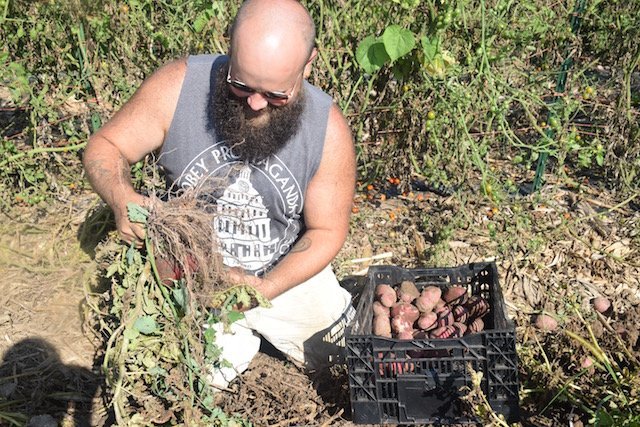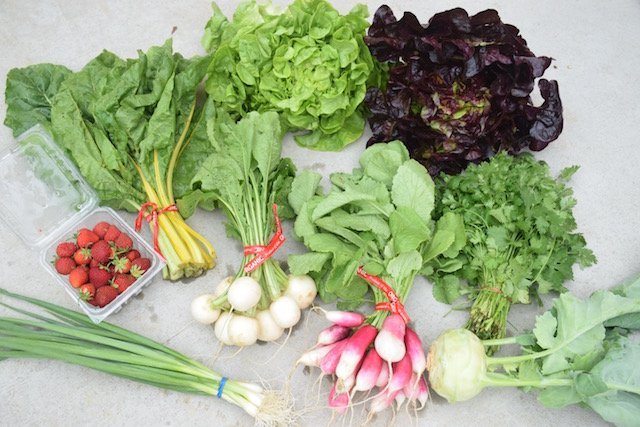
We are creatures of habit seeking comfort and familiarity. We wade in the predictable and the known. Here in the ‘bread basket’ the primal fear of wondering if and when we will get to eat again is an un warranted stress in our climate of plenty and surplus. We live in the era of boundless options and cheap food. The lavish selection displayed before us at the grocery stores makes us feel rich and free. Maybe we are overwhelmed by the choices or feel burdened by the decision-making process of buying our groceries, but so many of us buy the same things at the grocery store time and time again.
When not ‘limited to’ your CSA box, in the off-season likely buy the same vegetables over and over again. In the winter you buy carrots, potatoes, onions, broccoli and maybe for fun a sweet potato or some sweet peppers. You go with what you know. The vegetative variety in your diet dwindles back down again to your comforting staples. And I am here to admit that I do the same thing!
I believe there is a perfectly good explanation for this. I feel bored and unimpressed by the mystery vegetables from the grocery store. I feel a strong lack of connection with those orphaned vegetables with no one to tell their story for them. No face or place or season to foster my attraction. Which part of the country did those cucumbers come from? Did the garlic really come all the way from China? Why? Which continent did those grapes or asparagus come from? How in the world did they ship these tons and tons of perishable products to my local grocery store and all of the other local grocery stores in every small town across America? I should be blushing with excitement and fully captivated when I see these colorful (and undoubtedly impressive) displays, but usually, it just makes me miss summertime.
By February, my mouth waters for fresh, local greens. What I wouldn’t do for a lowly local zucchini in March. The humble cucumber that piles up by the truck-load on the farm in July has suddenly earned the status of a King to me by March. I would pay for its weight in gold if it were local and pulled from a vine in my then-frozen fields.
By the start of CSA season in June, the common radish is welcomed with such gusto we feature them on our salads proudly at the dinner table. The small and simple things like head lettuce and salad turnips make us feel alive again in a truly nourished way when we know they come from ‘the farm’. Feeling connected to the season that the produce was grown in somehow makes a world of a difference to us. And the added bonus of knowing the ‘who’ and ‘where’ the produce was grown nourishes not only our tummies, but also our hearts and our communities.
I know you feel this too. The Midwestern growing season is magical to us Midwesterners. We’re suddenly broadening our spectrum of what vegetables appeal to us. We re-discover pac choi, salad turnips, and asparagus and we enjoy their flavors and anxiously await even more variety as Spring turns into Summer.
I applaud your efforts at making time to cook with these vegetables and trying new recipes. Lets all cheers to the return of swiss chard and high fives all around because nothing compares to a fresh picked, local and organic strawberry!
Lettuce x 2- Red oakleaf lettuce and/or green oakleaf lettuce. These are such a wonderful Spring treat. Lettuce like this only grows in the cool weather of the Spring and Fall. In the summer months you’ll only be getting red and green leaf lettuce, but these butterheads/oakleafs sure are a treat! Enjoy!
French Breakfast Radish– A beautiful radish harvest! These are a less common variety of radish with much of the familiar flavor of the cherry bell, but a bit more tender. Don’t forget that the greens on radishes are edible!
Cilantro- Cilantro loves to be harvested in dry weather conditions, for the best shelf-life but because of our rainy harvest mornings, we had to harvest cilantro when it was wet and muddy. We did our very best to wash the cilantro. We recommend using up your cilantro as soon as possible because since had to get it wet, it won’t keep quite as long.
Kohlrabi- You may have received either a purple or a white kohlrabi. Kohlrabi are in the brassica family (relatives to cabbage, broccoli, cauliflower, kale, ect) and their leaves can be used like kale. Peel the round bulb and cut up the insides into veggies sticks and enjoy them with your favorite veggie dip or as a snack raw. For some strange reason, kohlrabi has the best flavor if eaten immediately after you cut it open. If you decide to save the other half for later, it usually develops a bitter flavor in the fridge. Good raw or cooked!
Green Onions- Cute little bunches of green onions this week. These are wonderful sliced thinly onto salads, used in stir fry, or any other way that you might use an onion. The greens are edible all the way up to the tips and make a beautiful garnish!
Swiss Chard– Swiss chard has all of the lovely tenderness of spinach and is in the same family as spinach and beets. It does have some of the earthy flavor that beets have. The chard stalks are even edible, don’t toss those!
Strawberry Quarts- Finally, a fresh quart of strawberries for everyone! Nothing compares to a fresh, local, seasonal strawberry! Strawberries are highly perishable, so please do eat them up as soon as possible for best flavor! We love making strawberry cream pies (no cooking or oven required) that use one whole quart on top which is a great way to ensure everyone gets some strawberries and not just the sneakiest ones in the family;)
Hakurai Salad Turnips- These are the white radish/turnip looking bulbs in your box. About 8 nice turnips per box. We found that these had a mild-sweet flavor to them. Use a mandolin and shave them onto a salad. Such a lovely Spring treat!
Home Made Cilantro-Lime Salad Dressing
Fettucini with Swiss Chard, Currants, Walnuts and Brown Butter
|
COMFORTING CLASSIC Chef Salad with Kohlrabi, Salad Turnips, and Cannellini Beans Penne with Chard, Bacon and Feta OUTSIDE THE BOX |